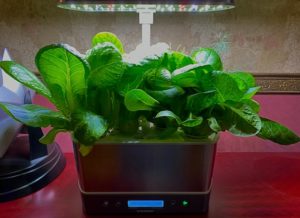Right now it seems everybody’s looking for ways to a) stretch those food dollars and b) make trips to the grocery less frequent. One way to meet both those goals is to grow your own food!
With groceries and fast-food restaurants running out of meat, this is a plant-based advantage: Theoretically, anything we eat we can grow and harvest ourselves. In reality, of course, very few home gardeners grow more than about a dozen types of edible plants, and which those are may depend on local conditions.

Romaine lettuce growing in an Aerogarden unit. (Photo courtesy of Amy Guskin)
Those conditions vary, of course: Some of us have land where we can plant seeds in the ground, whether in our own yard or a community garden. But there are situations where that’s not possible. Still, we can grow some things, even in tiny spaces, and offset our food costs and our masked excursions. Here are a few ideas to get you started.
Let’s say you have either a balcony or a nice-size window that gets good direct sun. A window box for fresh herbs is certainly doable. Usually this will be a structure hanging off the outside of a window but indoor herb gardening is also doable by lining up plants on the interior of a window. The page How to Culinary Herb Garden suggests that if growing indoors you keep separate herbs in separate plots to be able to respond to different light or other needs.
As for window boxes, they’re rectangular plant pots, essentially, so your key elements are soil, room for roots, and drainage. Store-bought window boxes are available with these kinds of structures built in, though if you’re handy (or have an odd-shaped space available) you may prefer to make your own.
In terms of which herbs to grow, this primer from Fine Gardening suggests chives, parsley, lemon thyme, basil, cilantro, and/or French tarragon, though plenty of others are possible. Two rules to remember in terms of plant selection: “avoid mixing those that like plenty of water (such as chives, mint, chervil, coriander, Vietnamese coriander) with those that like a well-drained soil (such as rosemary, thyme, sage, bay, and oregano).”
What if you have a source of sun but no room for a window box — or you want to grow some things too big for that narrow box? You can still do container gardening in small spaces, in a pot or, as an increasingly popular option, in a bag. “Grow bags” can be had for less than $20 and often come with lift-up windows down where the roots are so you can monitor them, and you can also grow root vegetables such as potatoes, carrots, onions, and radishes.
Then again, if you’re willing to spring for equipment, you can grow food with no dirt or sunlight at all. Hydroponics have over the years become more user-friendly and there are complete systems, including the lights, available for the cost of a few grow bags. Amy Guskin, a Philadelphia-area voice-over artist, musician (that’s how I know her), and foodie, said via email that she’s been delighted with the lettuce and herbs she’s producing from a small Aerogarden unit: “You put little baskets with moss plugs, containing a seed or two each, into slots in the top ‘deck,'” she explains, and “they draw on water (and a small amount of liquid plant food every 2 weeks) in a receptacle beneath them, and grow.”
Five weeks after starting, she says, she has four romaine plants, one plug of dill, and one plug of mint. “The rapid sprouting time is really great,” she notes, “if you’re the type of person who doesn’t manage to get your seeds started indoors in March!”
While some people use this type of system to start seeds for outdoor planting, that’s not necessary, says Guskin, “as long as you are growing something conducive to the format. My unit is fairly small, and the light source only gives you about 12” of clearance from the deck, so you couldn’t plant, say, corn in it.”
Either way, the versatility is the main point of going this route: “You can put it anywhere you can fit it,” she says. “In an internal room with no windows. In a bathroom. In a closet!”
Meanwhile, with that extra room available on the counter, another mini-gardening possibility is re-growing your kitchen scraps – the cut-off ends of things like celery and root veggies that you might otherwise toss out.
The system is simple: Put that throwaway end in a small glass of fresh water (you can also buy custom-made units for this purpose), with the end pointing down and the cut-off part pointing up (with toothpicks sticking out if necessary to keep it oriented right), and wait for it to work its magic. Guskin is also an enthusiast in this area, underscoring that you needn’t limit yourself to one method at a time.

Scallions, celery, and lettuce being regrown from scraps in the kitchen (Photo courtesy Amy Guskin)
“I’m flabbergasted by how quickly these things are shooting up with new growth!” Guskin says. On her sill now in glasses are “lettuce, celery, scallions, onions, a yam, and even a parsnip!” She notes she was “astonished by how quickly the celery sprung up, despite the base looking like it was NEVER going to be able to sprout roots!” Once they’re growing on your windowsill (this project will need a steady source of sunlight) they can continue indefinitely.
And for some scraps you can even forgo the water, at least for a while. “The garnet yam and the parsnip volunteered to be re-grown,” Guskin says, and are not in water. “They are just growing from their own internal resources. There’s no reason you couldn’t plant those in a pot and put them on a balcony or by a sunny window.” Next week she’s planning to nest those two vegetables in a small amount of soil to get some roots started, “and later this season I will put them outside.”
Next week we’ll move outside as well, to consider home-growing tips for those with outdoor space available. Stay tuned, and stay crunchy!




